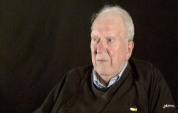6:00 | After spending time in Guadalcanal, New Zealand, and New Guinea, Jim Tysinger's unit arrived at Leyte. Upon arrival, he wondered to himself why the Navy hadn't started firing when they were supposed to. He then found out that the Japanese were no longer there.

The age limit to become an officer was lowered to 20. Jim Tysinger took advantage of this opportunity and headed towards Camp Davis in North Carolina. After being commissioned, Jim was ordered to transfer into the 214th Coast Artillery Anti-Aircraft regiment in California. He then visited New Caledonia and went on to Guadalcanal. During this time, his battery commander got promoted which resulted in him being his replacement.
Jim Tysinger explains that, in 1940, the Army was small which resulted in outdated equipment. The Army had to use WWI equipment, 2x4s as machine guns, and anti-aircraft guns as their guns. At that time, the Army didn't even have tanks. In order to do maneuvers, the Army wrote the word tank on the side of a truck.
The Japanese, just 50 feet above Jim Tysinger's head, flew past him and bombed one of the nearby ships, barely missing him. There was also a major attack coming from the north of them. It was the last big raid and around 100 Japanese fighters were ready. Fortunately for Jim, this time everyone was prepared and took down all the Japanese fighters.